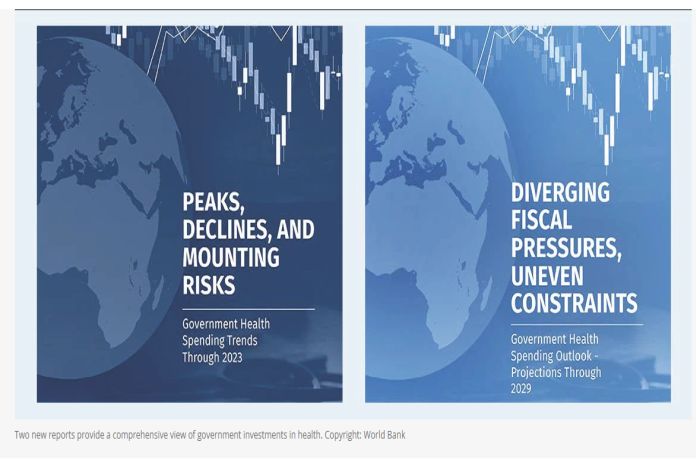By Christoph Kurowski, Martin Schmidt, and David B. Evans
Countries are entering a critical phase in achieving the health Sustainable Development Goals (SDGs), with Universal Health Coverage (UHC) at the core of these efforts. With only six years remaining to meet these goals, global progress toward UHC has been slow, and the COVID-19 pandemic has led to significant setbacks.
At this pivotal juncture, we introduce two new reports that provide a comprehensive view of trends and prospects of government investments in health for almost the entire SDG period (2015-2029). The first examines government health spending trends in 63 low- and lower-middle-income countries from 2015 to 2023, while the second offers an outlook on government health expenditure for 170 countries through 2029. In contrast to expenditure figures, spending estimates exclude obligatory contributions to social health insurance, which, however, generally constitute only a minor source of public funding for health in low-income countries (LICs) and lower middle-income countries (LMICs).
The findings from these reports reveal troubling trends across LICs and LMICs, exposing serious risks to the sustainability of health investments. Fully attaining the SDG health targets is slipping out of reach for many nations, highlighting the urgent need for decisive action to address growing financing challenges. With these targets at risk, the World Bank Group remains committed to helping countries deliver quality, affordable health services to 1.5 billion people by 2030 as part of our global mission to ensure a basic standard of care throughout every stage of life.
Mounting risks
In the years following the pandemic, LICs and LMICs have, on average, seen a steady decline in per capita government health spending. While this may appear to be a natural adjustment from the pandemic-induced spending surge, a closer look raises significant concerns about the future of public investments in health.
Following a pandemic-related increase in health spending, steady declines have resulted in only modest growth in per capita government health spending during the pandemic and recovery phases – a sharp contrast to the strong and sustained momentum before the pandemic. This slowdown is due to a shrinking share of health within expanding government budgets.
These overall trends are driven by 35 countries, collectively home to over 2.5 billion people, where in most cases both per capita government health spending and the health share of government budgets have declined between 2019 and 2023, and in only a few where just one of these critical factors has fallen.
Diverging fiscal pressures
Fiscal forecasts point to additional challenges ahead. According to the IMF’s World Economic Outlook released in April 2024, per capita general government expenditure is projected to grow moderately across all income groups. However, these broad forecasts mask significant disparities. Of the 170 countries analyzed, 74 are projected to experience substantial growth in real per capita general government expenditure between 2019 and 2029. In contrast, 67 countries are expected to see sluggish growth, while 29 are forecast to face contractions in per capita spending over the same period.
These discrepancies create distinct fiscal pressures on the sustainability of health funding. In countries with contracting budgets, real health expenditure per capita is projected to decline between 2019 and 2029, regardless of whether the health share in general government spending returns to pre-pandemic levels or remains elevated—two key scenarios explored in the report. Similarly, countries with stagnating budgets are expected to see only modest growth in health expenditures. In both cases, spending will fall well below the per capita levels projected based on historical growth rates observed from 2000 to 2019.
The situation is especially problematic for LICs and LMICs. As mentioned, many of these countries have experienced negative growth in the health share of general government expenditure; moreover, rising interest payments on public debt limit their ability to allocate resources to health.
Confronting health financing shortfalls
The likely spending trajectories for LICs and LMICs are, with few exceptions, insufficient to meet the per capita government health spending levels necessary to achieve global health goals by 2030. Without decisive policy action, particularly in countries with contracting or stagnating fiscal space, government health spending will continue to fall short of essential minimum levels.
To address these financing shortfalls, governments must prioritize health in their spending decisions. In addition, complementary domestic policies are crucial, including fiscal reforms to enhance government revenues and measures to improve spending efficiency, such as eliminating ineffective subsidies and combating corruption.
Rethinking health investments
Recent spending trends and projections do not bode well for achieving global health goals. If funding shortfalls are not addressed, the consequences will be profound. Ministries of health will lack the resources to strengthen pandemic prevention and preparedness, bolster health systems more broadly, enhance financial protection, and improve health outcomes. Insufficient investments in health will undermine human capital development, leaving ministries of finance grappling with weakened foundations for long-term growth and revenue generation. Meanwhile, development partners risk seeing gains from their assistance reversed, alongside slow progress on global priorities, including pandemic prevention and preparedness.
The SDG era was envisioned as a transformative period for global health – a time of accelerated progress and bold achievements. However, pandemic setbacks and mounting financing challenges have introduced new realities that, if unaddressed, will redefine this era as one of limited gains and unmet promises. A critical reassessment of financing approaches to achieve health-related SDGs is now essential, with careful consideration of today’s macro-fiscal headwinds and multiplying development obstacles. The data presented in both reports will help policymakers engage in dialogue and shape effective responses. Encouragingly, the analyses also demonstrate that even amid these pressing challenges, some countries are already pursuing strategies to expand health investments, demonstrating that progress is possible.
![]()





